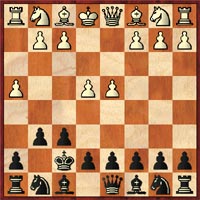 |
 |
 |
 |
 |
 |
 |
 |
 |
 |
|
|
|
|
|
|
|
|
|
|
|
 |
|
|
|
|
|
|
|
|
"The Jones Defense": A 1920s Relic
|
|
|
|
|
|
|
|
|
|
|
|
|
Two weeks ago on these pages, Bernard Parham's "Matrix System" was profiled and has become the subject of intrigue for the past 30 years. The system entails geometric maneuvers, permutation calculations, a unique annotation system and… a rather crude opening system. In Indiana, Parham is famous for his 1.e4 and 2. Qh5 move order and it has become known as the "Parham Attack."
Wade Thames of California told The Chess Drum of a discussion at rec.games.chess.misc that occurred years ago on irregular openings such as 1.a3 2.h3 3.Ra2!? and 1.a3 g6! 2.h4! These systems were made famous by English IM Michael Basman, an avid fan of irregular opening systems (e.g., 1. g4 or 1. e4 g5 and 1. d4 a6 2. e4 h6).
|
|
|
|
|
|
|
|
|
|
|
|
|
In the discussion, Max Burkett of Montana made mention of a Black man in the San Francisco Bay area who patented what became known as the "Jones Defense." The defensive setup arose after either 1.f3, 2.g3 and 3.Kf2 or 1…f6, 2…g6 and 3…Kf7 (see diagram) and was named for Leo Jones, said to be America's first Black expert player around the 1920s. While there is little data to corroborate the story, it is plausible that such an opening could have presented difficulties since there was little theory at the time. Burkett gave 1.e4 f6 2.d4 g6 3.h4! as the critical line.
|
|
|
|
|
|
|
|

|
|
|
|
|
|
|
|
|
|
|
In the old game of "Shatranj" there was an opening that entailed white moving his kingside soldiers (pawns) up one rank and then playing the chariot (rook) Rh1-h2 and then Rh2-f2. Of course, there was no castling in this form of chess. While it is not certain that Jones was familiar with Shatranj theory, he played chess in truly a renaissance period and perhaps he is one of many obscure players having made a contribution to the royal game. How would the Jones Defense have done against the Parham Attack? Needless to say, this would have been an interesting debate… pure attack versus pure defense.
Read interesting discussion about irregular openings
at
rec.games.chess.misc
|
|
|
|
|
|
|
|
|
|
|
|
|
|
|
 |
|
|
|
|
 |
